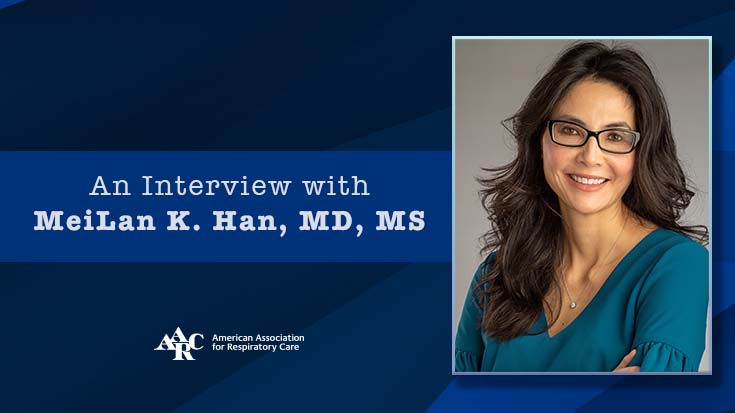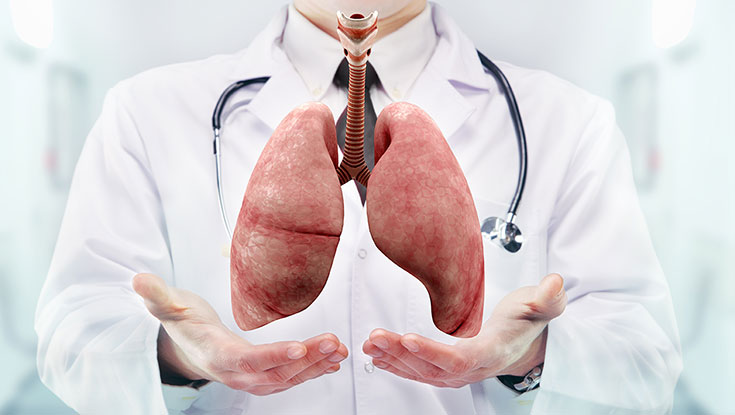
In addition to serving as the lead investigator on several NIH-sponsored COPD studies, Dr. Han co-authored the University of Michigan COPD Guidelines. She serves on the scientific advisory committees for the COPD Foundation, American Lung Association, and Global Obstructive Lung Disease, and is a deputy editor for the American Journal of Respiratory and Critical Care Medicine.
Dr. Han delivered the Thomas L. Petty Memorial Lecture at AARC Congress 2017 in Indianapolis, IN.
As the pandemic progressed, Dr. Han saw a unique opportunity to educate health care workers and the general public alike about the inner workings of the lungs and recently brought that goal to fruition with the publication of Breathing Lessons: A Doctor’s Guide to Lung Health.
She shares her take on chronic lung disease, the role of RTs, and how she believes her new book can help raise awareness about lung disease with us here —
From your perspective as a leader in lung disease research and advocacy, what do you believe are the major unmet needs of our chronic lung disease patients?
There are many issues related to lung disease and lung health that weigh on me heavily. We have many patients with chronic lung diseases who don’t even know they have a lung condition. Patients with many types of lung disease tend to get picked up rather late in the disease course, which means there is less we can do to help such patients when they are finally diagnosed.
We also need more and better treatments for patients with all types of lung disease. One of the points I make in my book, Breathing Lessons, is that we have not invested as we should have into understanding both lung disease and how to preserve lung health. Now that we are in the middle of a respiratory pandemic, we are paying the price for this lack of investment.
What do you believe respiratory therapists can do, or should be doing, to help improve on this situation, and why are RTs the right people to get more involved?
There are so many ways that respiratory therapists could help. I think we need greater presence of respiratory therapists within the outpatient primary care setting where they could help with screening for lung disease, help to perform spirometry to diagnose lung disease, as well as help ensure patients understand how to use treatments prescribed for them. I am very fortunate to be able to work with respiratory therapists in my own outpatient clinic, where they are an invaluable resource. Many primary care clinics, however, lack anyone with the expertise that respiratory therapists have, such that I think they could make a huge contribution.
The pandemic has created a new type of chronic lung disease in long-COVID. What is your vision of the next two to three years regarding post-COVID?
One of the things we are learning is that pre-existing lung inflammation may both predispose patients towards developing symptomatic COVID-19 and also may be a forerunner to long-COVID. This is why I believe the problem we have with under-diagnosis of lung disease is now an emergency. COVID has exposed a problem we didn’t fully realize we had and further highlights our inability to help patients recover from acute lung injury.
My hope is that the virus will continue to mutate towards milder variants and burn itself out. Yet, at the same time, my greatest fear is that we will miss the lesson the pandemic has to teach us, that we need greater investment in preventing and treating acute lung injury as well as diagnosing lung diseases in general.
Where do you believe we need more RTs? Hospitals, doctor’s offices, clinics, etc.?
I love working with RTs. I would love to see both our outpatient and inpatient settings better resourced with RTs. I have been fortunate to work with respiratory therapists in the outpatient, inpatient, and pulmonary rehabilitation settings. I think, however, that perhaps the best investment we could make would be greater RT presence in primary care offices where they could help with screening, spirometry, and ensuring patients are taking and using medications correctly, as well as aid with oxygen therapy.
Pulmonary rehabilitation has been shown to improve quality of life for chronic lung patients, but it suffers from reimbursement issues and a dearth of programs in many areas of the country. How do we fix that, and what can RTs do to improve referrals and compliance?
The benefits to pulmonary rehabilitation are clear, but the situation is becoming very, very frustrating. I was hoping that the pandemic would aid in this regard, but it is unclear to me that the changes we need will occur. We don’t have enough pulmonary rehab facilities where the patients are who need it most. While we have seen an increase in virtual care, whether this is the best solution for patients and the future of reimbursement is very uncertain. I think RTs can help by increasing awareness to promote referrals as well as advocacy and petitioning of CMS to improve coverage for needed services.
You’ve just published a book called Breathing Lessons: A Doctor’s Guide to Lung Health. What drove you to write the book, and what do you hope to accomplish with it?
At the beginning of the pandemic, I found myself bombarded with questions about how the lungs worked and what happens when lungs fail. I had the opportunity to do an episode of the Freakonomics podcast explaining some of these concepts, which ultimately led to the book that I published in conjunction with WW Norton. I realized there really was no resource that explained in clear terms how the lungs work, how lung disease affects the lungs, and perhaps more importantly, discussed the concept of lung health.
In the book, I explain that there is much we can do over our lifetime to protect our lungs and promote lung health, which is just as important if not more important than thinking only about lung disease. I’ve already heard from several RTs that they’re finding the book a useful resource. I’m hoping I can get the book into the hands of even more patients as well.
I think lung disease has been a mystery for too many for too long. If we don’t understand something, we tend to ignore it. By empowering people, my hope is that I can help people become true partners in their health.
Learn more about Dr. Han’s new book here.
Email newsroom@aarc.org with questions or comments, we’d love to hear from you.















